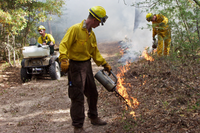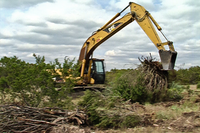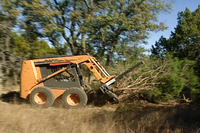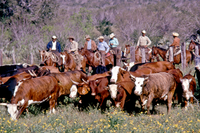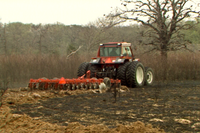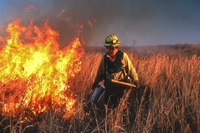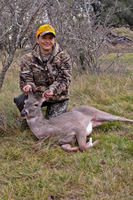Wildlife Management
The Wildlife Division of Texas Parks and Wildlife advocates an ecological approach that blends social, physical, economic, and biological needs and values to assure productive and healthy ecosystems. No single species is targeted for enhancement but rather the habitat is managed to maintain ecological processes, functions, diversity, and productivity over time. This is achieved through Land Stewardship, caring for land and resources to pass on healthy ecosystems to future generations.
As Aldo Leopold wrote in his 1933 textbook titled Game Management, "The central thesis of game management is this: game can be restored by the creative use of the same tools which have heretofore destroyed it- ax, plow, cow, fire, and gun. Management is their purposeful and continuing alignment."
Axe
The axe is synonymous with methods and techniques used to manage woody vegetation. Overgrazed rangelands often lead to the invasion by woody species. Openings, clearings and areas once dominated by native grasses often become infested with juniper and mesquite which over time dominate the landscape. Brush management (the axe) is often necessary to maintain or improve the quality of rangelands for livestock grazing and habitat for wildlife.
Cow
Free-ranging bison, pronghorns, white-tailed deer and cattle were present in Texas until the mid to late 1800s. The appearance of barbed wire fences restricted movement of livestock and native wildlife. Large areas of grasslands that were once subjected to intensive short term grazing by bison and free ranging cattle were now being grazed year round. Highly preferred native grasses were grazed-out, only to be replaced by less palatable native and non-native species, brush, and noxious species. Today, cattle can be used as a tool to manipulate and enhance wildlife habitat and plant diversity (as bison did), through proper grazing rates and by a scheduled rotation of rest periods to allow pastures to be free of grazing by domestic livestock for a specified time of the year.
Plow
Tilling the soil is another approach to setting-back plant succession to promote the growth of desirable wildlife foods (forbs). Bison once "tilled" the soil as they moved and grazed through areas, promoting more plant diversity. Today, soil cultivation by mechanical equipment can be used to set back plant succession (winter fallow disking (PDF 259.1 KB)), plow and plant native grasses and forbs back in fields or on rangelands (rangeland reseeding), planting annual or perennial vegetation as crops or as food plots for wildlife (farming), and mowing vegetation to reduce thatch or old growth of vegetation to stimulate new growth and greater plant diversity (mowing). Any plans for soil cultivation operations to improve habitat for wildlife must take into consideration the impact on existing native vegetation, potential for increased soil erosion, and soil type.
Fire
Fires, natural and man-made, played an integral role in the evolution of plant communities. Since the late 1800s, man has suppressed fire to protect fences, buildings, homes, and other land improvements. Suppression of fire and overgrazing by livestock of native grasses has resulted in an increase in oaks and the invasion by brush species such as mesquite and juniper. Burning can promote an increase of native perennial grasses and forbs and enhances habitat diversity for a wide variety of wildlife species. It will also help reduce the invasion of invasive woody species onto rangelands and grassland openings. Many plant species are tolerant of fire and others require fire to stimulate germination of seeds. Use of prescribed "cool season" fires during the winter months and prior to spring green-up is preferred to minimize the impact on wildlife species and critical nesting habitat for birds. For more information on prescribed burning, please see Prescribed Range Burning in Texas (PDF 362.1 KB).
Gun
Hunting (the gun) is an important tool available to landowners to help maintain a balance between deer numbers and the ability of the habitat to support healthy individuals and populations of deer. In areas where deer numbers are allowed to exceed the carrying capacity of the habitat, habitat degradation will result, thus impacting food and cover required by many other species of wildlife. Hunting is an effective tool available to landowners to help maintain white-tailed deer number at or below the carrying capacity of the habitat and to diminish the impact of growing numbers of feral hogs and other exotic animals. Hunting revenue is also an incentive for landowners to provide and manage good quality habitat for deer and other wildlife species.
